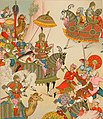File:Babur setting out with his army.jpg

Original file (875 × 1,024 pixels, file size: 402 KB, MIME type: image/jpeg)
Captions
Captions
Summary edit
| DescriptionBabur setting out with his army.jpg |
English: Racinet's view of Babur setting out with his army (1876); *a larger scan*
Source: ebay, Jan. 2002 "Color Lithograph from 1876. Military Costumes of India - 16th Century. Legend: 'These fragments are taken from a 16th C. painting representing Djahir - El-din Mohammed, Bâber nicknamed (the Tiger), the king and emperor of India, leaving at the head of his army to invade the province of Mazindera, in Persia. He was the Indian emperor (1526-30) and founder of the Mughal dynasty of India, a descendant of the Mongol conqueror Genghis Khan and also of Timur (Tamerlane). He was a military adventurer and soldier of distinction and a poet and diarist of genius, as well as a statesman. Babur is rightly considered the founder of the Indian Mughal Empire, even though the work of consolidating the empire was performed by his grandson Akbar. Babur, moreover, provided the glamour of magnetic leadership that inspired the next two generations. Babur was a military adventurer of genius, an empire builder of good fortune, and an engaging personality. He was also a Turkey poet of considerable gifts that would have won him distinction apart from his political career. He was a lover of nature who constructed gardens wherever he went and complemented beautiful spots by holding convivial parties. Finally, his prose memoirs, the Babur-nameh, have become a world classic of autobiography. They were translated from Turki into Persian in Akbar's reign (1589) and were translated into English in two volumes in 1921-22 with the title Memoirs of Babur. They portray a ruler unusually magnanimous for his age, cultured, witty, convivial, and full of good fellowship and adventurous spirit, with a sensitive eye for natural beauty. In this print, the Mogul is represented with all the attributes of the ruler, especially the parasol, carried over him. He is wearing a silk jacket, short sleeved, and a round shaped skirt, with ornamental design and large metal button-plate on his chest. The jacked is padded to protect against the arrows and his knees are also protected by metal plates. In his right hand, he is holding one of the offensive weapons of the time, a spear, with ends being finished with decorated metal, on the left side he wears a saber and on his belt, a quiver with feather arrows is attached. The soldier behind him carries a hammer like weapon, which could also be a heavy wood club, he is holding it with both his hands, indicating the heaviness of the weapon. The mogul's horse is entirely protected with armor of overlapped blades. An interesting feature is that he does not were the rider's boots but his personal slippers. Another interesting feature of this painting is the lack of elephants in his army. Before the ruler, we see a number of infantrymen who proceed him and by shouting create a necessary room for him to pass." |
| Date | |
| Source | http://www.columbia.edu/itc/mealac/pritchett/00routesdata/1600_1699/french/racinet/racinet.html |
| Author | Racinet |
Licensing edit
| Public domainPublic domainfalsefalse |
|
This work is in the public domain in its country of origin and other countries and areas where the copyright term is the author's life plus 70 years or fewer.
| |
| This file has been identified as being free of known restrictions under copyright law, including all related and neighboring rights. | |
https://creativecommons.org/publicdomain/mark/1.0/PDMCreative Commons Public Domain Mark 1.0falsefalse
File history
Click on a date/time to view the file as it appeared at that time.
| Date/Time | Thumbnail | Dimensions | User | Comment | |
|---|---|---|---|---|---|
| current | 02:09, 10 October 2017 |  | 875 × 1,024 (402 KB) | Bellerophon- (talk | contribs) | more close to original color? |
| 12:41, 21 November 2015 |  | 803 × 927 (608 KB) | శ్రీధర్ బబు (talk | contribs) | larger | |
| 14:24, 9 November 2015 |  | 950 × 1,454 (687 KB) | శ్రీధర్ బబు (talk | contribs) | larger | |
| 14:22, 9 November 2015 |  | 513 × 595 (99 KB) | శ్రీధర్ బబు (talk | contribs) | User created page with UploadWizard |
You cannot overwrite this file.
File usage on Commons
There are no pages that use this file.
File usage on other wikis
The following other wikis use this file:
- Usage on ar.wikipedia.org
Metadata
This file contains additional information such as Exif metadata which may have been added by the digital camera, scanner, or software program used to create or digitize it. If the file has been modified from its original state, some details such as the timestamp may not fully reflect those of the original file. The timestamp is only as accurate as the clock in the camera, and it may be completely wrong.
| Image title | brg214275 |
|---|---|
| Author | QuanJing |
| Copyright holder | Copyright:www.quanjing.com |
| Orientation | Normal |
| Horizontal resolution | 300 dpi |
| Vertical resolution | 300 dpi |
| Software used | Adobe Photoshop CS4 Windows |
| File change date and time | 11:29, 28 July 2012 |
| Color space | Uncalibrated |